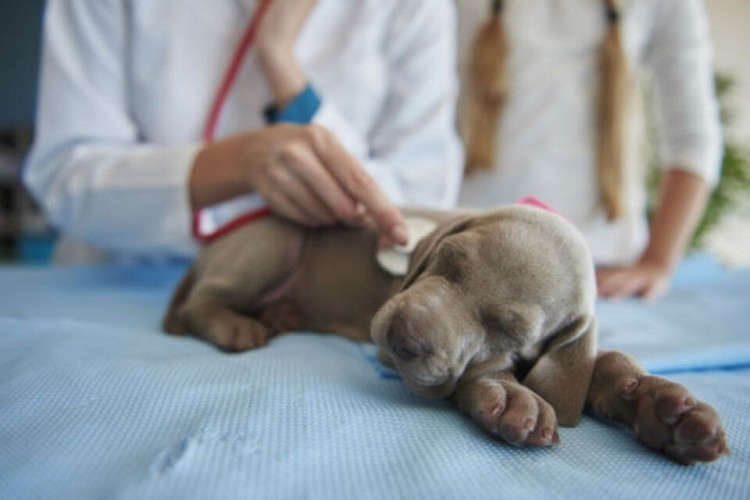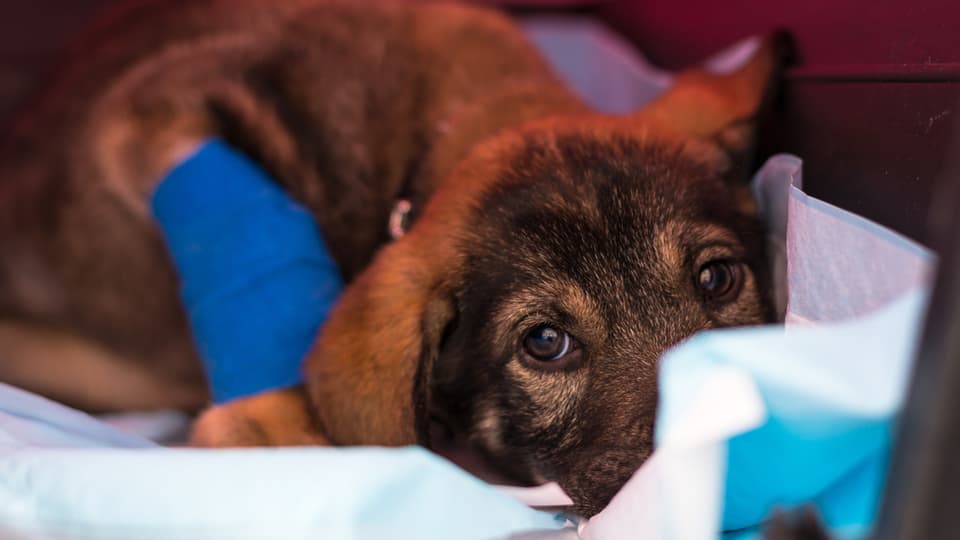Puppies are very susceptible to many illnesses because their immune systems are not fully developed. One example is parvo, a nasty virus that attacks the intestines causing severe diarrhea, vomiting, and dehydration. Parvo is very contagious and particularly dangerous for unvaccinated puppies less than six months old.
This guide will tell you everything you need to know about parvo in puppies, including the most common parvo symptoms and the steps you can take to protect your pet from this potentially deadly disease.
Pro tip: Pet insurance will cover parvo if your puppy has received all their routine vaccinations. It's best to enroll before your puppy develops health complications, otherwise the condition may not be covered.
Table of Contents:
- What is parvo?
- Where does parvo come from?
- What are symptoms of parvo in puppies?
- How do you treat parvo in puppies?
- How long does parvo last in puppies?
- How can you prevent parvo in puppies?
- Key Takeaways
What is parvo in puppies?
Canine parvovirus, known as parvo or CPV, is a highly contagious virus that attacks the gastrointestinal (GI) system of puppies and young dogs. The virus can spread easily through contact with an infected pup or by indirect contact with a contaminated object, such as water bowls, toys, and even the hands of humans.
The virus attacks the stomach and small intestine, destroying cells, impairing nutrient absorption, and disrupting the intestinal barrier. In puppies, parvo can also affect the lymphopoietic tissue and bone marrow. In some cases, parvovirus can infect the heart muscle (cardiac CPV), which is usually fatal but far less common.
The virus is cold- and heat- resistant with the ability to survive up to one year outdoors and five years indoors. CPV is resistant to alcohol, detergents, and many disinfectants, which is why it can be difficult to contain.
 (Image source: American Kennel Club)
(Image source: American Kennel Club)
Where does parvo come from?
Puppies are exposed to parvo anytime they smell, lick, or touch infected feces - which can be particularly problematic for young dogs exploring the world with their senses. Parvo transmission in puppies can also occur anytime they come into contact with a contaminated object or person in their environment. Even shoes that step on infected feces can bring the virus into the house, where it can live in soil for up to a year.
Although all dogs are at risk, parvo is most common in unvaccinated puppies between six and 12 months old. Fortunately, pups younger than six weeks still retain some of their mother’s antibodies, provided that she received the full course of the vaccine. Pet parents should note that certain breeds are at a higher risk of becoming infected with parvo, namely:
- American Staffordshire Terrier
- Doberman Pinscher
- English Springer Spaniel
- Labrador Retriever
- German Shepherd
- Rottweiler
Take extra precaution to protect against parvo in puppies that belong to these breeds.
What are the symptoms of parvo in puppies?
Puppies with parvo begin shedding the virus within four to five days of exposure, usually before clinical signs develop. As the illness sets in, some of the most common parvo symptoms in puppies include:
- Vomiting
- Diarrhea (often bloody)
- Fever
- Weight loss
- Lethargy
- Dehydration
- Weakness
- Anorexia
- Depression
If you notice any of the red flags above, contact your vet ASAP. Make sure to inform them ahead of time of the puppy’s condition and your concerns, so that the staff can take the necessary quarantine measures to prevent further transmission.
How do you treat parvo in puppies?
First, your veterinarian will run blood tests to confirm your puppy has parvo. The vet might also run an ELISA test to look for CPV antigens in the feces.
Parvo weakens a puppy’s immune system, lowers the white blood cell count, and damages the intestinal wall, reducing the pet’s ability to combat secondary bacterial infections. The mortality rate in canines that receive no treatment is over 90%, compared to 10-25% in those that are hospitalized. Therefore, hospitalization is strongly recommended for puppies with parvo symptoms.
Hospitalizing a puppy for parvo treatment costs about $2,000 to $3,000 just for the first day. Some patients might have to stay in the hospital for three to five days depending on the severity of the case (very sick puppies might stay in the hospital for up to ten days if they require intensive care).
Puppies infected with parvo will be placed in an isolation ward to prevent transmission between doctors, nurses, or other animals in the hospital. They will also receive IV fluids, pain medication, anti-nausea medication, and antibiotics. A nasogastric tube might also be necessary in order to provide nutritional support.
If hospitalization is not possible due to financial reasons, there’s an outpatient protocol that includes learning how to administer anti-nausea medication and IV fluids under the puppy’s skin, administering oral medications, and checking their temperature. Frequent vet visits will be necessary to check blood sugar levels and electrolytes on a daily basis. This option may not be possible depending on the severity of the infection.
Your vet will recommend an appropriate treatment for your puppy’s individual case and let you know which precautionary measures you should take in order to protect any other dogs and puppies in your home.
Pro tip: Treatment for parvo can require 10 days of hospitalization. Without pet insurance that could cost hundreds or even thousands of dollars. Luckily, routine puppy vaccinations, which can be covered through pet insurance plans, include vaccinations for parvo. These vaccinations require multiple shots and vet visits, so pet parents should take some time to compare pet insurance plans and find a policy that will cover this routine care.
 (Image source: PDSA)
(Image source: PDSA)
How long does parvo last in puppies?
Most parvo patients recover if aggressive treatment is used and therapy is started before severe dehydration and septicemia occur. Most puppies that make it through the first three to four days will recover completely. Recovery usually takes about a week, but it depends on the severity of the case.
Some breeds, such as the Doberman Pinscher, English Springer Spaniel, and Rottweiler, have a significantly higher fatality rate than other dog breeds.
Puppies continue to shed the parvovirus for up to ten days after recovery, so make sure to keep any animals recovering from the virus away from unvaccinated or partially vaccinated dogs.
How can you prevent parvo in puppies?
Parvovirus is preventable through vaccination. Puppies shoulbe be vaccinated against the virus every two to four weeks starting at six to eight weeks old, up until they are at least 16 weeks old. The last shot at 16 weeks is required for coonfidence in lasting immunity. Until the round of vaccines is complete, they should be kept away from public areas where other unvaccinated dogs could be, such as dog parks.
Ensure that all dogs in your home are vaccinated. It’s very important that female dogs receive a full series of parvo vaccines, as the young puppies depend on the dam’s antibodies in their first weeks of life. Pregnant females can also be boosted with a parvovirus vaccine 2-4 weeks before giving birth in order to transfer higher levels of antibodies to the puppies. Your vet will help you make the final decision about a vaccination schedule that best fits your pet.
You should also be extra careful when socializing your pet. Until puppies have received all of their vaccines, they should be allowed to come into contact with unvaccinated dogs. Avoid dog parks as well as other places where canines gather and try to socialize your puppy in less public environments such as your home.
The stability of the parvovirus in the environment makes it very important to properly clean and disinfect contaminated kennels, crates, bedding, and other areas where infected canines are kept in order to keep the spread under control. A solution of 1 gallon of water and 1/2 cup of chlorine bleach will disinfect water and food bowls, as well as other contaminated items. Your vet can provide specific guidance on cleaning and disinfecting agents for your home.
Key Takeaways
- Parvo is one of the most contagious and potentially life-threatening canine diseases.
- Understanding how it spreads, the clinical signs, treatment options, and what you can do to prevent parvo in puppies will help keep your pet healthy and happy.
- Schedule your CPV vaccines as soon as possible, get in touch with your vet should you have any concerns.
